Canada AM: Behind the scenes: Richard Crouse gets Zombie-fied
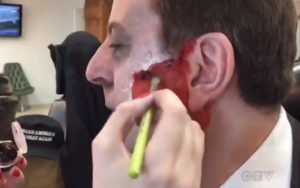 Watch Richard get zombie-fide in this CTV Digital Exclusive!
Watch Richard get zombie-fide in this CTV Digital Exclusive!
Watch the whole thing HERE!
 Watch Richard get zombie-fide in this CTV Digital Exclusive!
Watch Richard get zombie-fide in this CTV Digital Exclusive!
Watch the whole thing HERE!
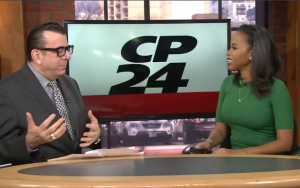 Richard’s alter ego Zomald Trump reviews the teenage Halloween freak-out “Scouts Guide to the Zombie Apocalypse,” and some more adult fare in the ghostly form of “Our Brand is Crisis,” “Truth” and “Suffragette.”
Richard’s alter ego Zomald Trump reviews the teenage Halloween freak-out “Scouts Guide to the Zombie Apocalypse,” and some more adult fare in the ghostly form of “Our Brand is Crisis,” “Truth” and “Suffragette.”
Watch the whole thing HERE!
 Richard’s alter ego Zomald Trump reviews the teenage Halloween freak-out “Scouts Guide to the Zombie Apocalypse,” and some more adult fare in the ghostly form of “Our Brand is Crisis,” “Truth” and “Suffragette.”
Richard’s alter ego Zomald Trump reviews the teenage Halloween freak-out “Scouts Guide to the Zombie Apocalypse,” and some more adult fare in the ghostly form of “Our Brand is Crisis,” “Truth” and “Suffragette.”
Watch the whole thing HERE!
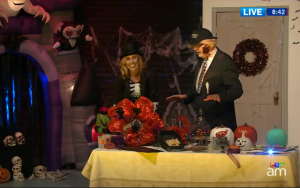 Zomald Trump and “Canada AM” lifestyle expert Katie Savage look at tricks and treats to make Halloween great at your house!
Zomald Trump and “Canada AM” lifestyle expert Katie Savage look at tricks and treats to make Halloween great at your house!
Watch the whole thing HERE!
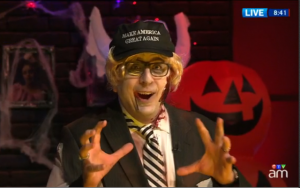 Richard (as Zomald Trump) hosts the “Canada AM” Halloween costume Parade!
Richard (as Zomald Trump) hosts the “Canada AM” Halloween costume Parade!
Watch the whole thing HERE!
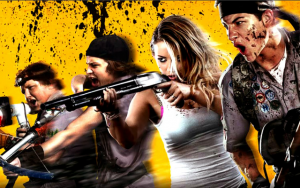 By Richard Crouse – Metro In Focus
By Richard Crouse – Metro In Focus
Movies like World War Z, Zombie Women of Satan and this weekend’s comedy-horror Scouts Guide to the Zombie Apocalypse — the story of three Scouts who must bond to save their town from a zombie outbreak — owe a debt of gratitude to Night of the Living Dead. In 1968, the story of story of people trapped in a rural Pennsylvania farmhouse trying to survive an attack by reanimated ghouls dragged a bloody new horror genre into the marketplace.
For better (see Re-Animator) and for worse (see Zombie Nightmare) the movie Rex Reed called “a classic” has spawned almost five decades of brain eating and head explosions, but according to the film’s co-author John Russo, the origin of the idea was anything but sinister.
“Sometime in the winter of 1966 George Romero and I were having lunch with Richard Ricci,” says Russo, then a co-partner with Romero and Russell Streiner (who has the film’s most famous line, “They’re coming to get you, Barbara!”) in The Latent Image, a commercial television production house.
“George and I were complaining about the fickleness of our commercial clients. Richard said, ‘So why don’t you do something about it?’ I thought about it and said, ‘We oughtta be able to make something better than the crap we see on Chiller Theater.’
“George right away got excited, slammed the table with his big hand, sending bottles and glasses flying, and yelled, ‘We’re gonna make a movie!’”
The two batted around several ideas. One, titled Monster Flick, was a horror comedy about teenage aliens, while another focused on flesh eating aliens.
“But we quickly discovered that we could not afford all the necessary special effects,” he says, so the writing continued.
“We’d go to work late at night in separate offices, at separate typewriters,” says Russo. “I said right away that our story should start in a cemetery because folks found cemeteries spooky. I was working on a script that started in a cemetery and involved aliens coming to earth in search of human flesh. But George took a break at Christmas time and came back with half of a story that started in a cemetery, and was in essence what became the first half of Night of the Living Dead. There were all the proper twists and turns and a lot of excitement, but George never said who the attackers were or why they were attacking.
“I said, ‘I like this, George, but who are these attackers? You never say.’ And he said he didn’t know. So I said, ‘It seems to me they could be dead people. But why are they attacking? What are they after?’ Again, he said he didn’t know. So I said, ‘Why don’t we use my flesh-eating idea?’ And he agreed. “So that’s how the modern flesh-eating zombies were born!”
These days it doesn’t take a lot of braaaaaaaaaaaaaaaains to see the legacy of Night of the Living Dead. The ghoulish story is considered a classic, has spawned comedies like the box office hit Zombieland and hit television shows like The Walking Dead.
“We were absolutely dedicated toward making a movie that was true to its premise and the motivations of its characters, from start to finish,” says Russo, adding, “[the movie] struck a primal chord in everybody, perhaps because of the atavistic memory of our species as easy prey for wild beasts, which we were for most of human history. We all carry the deep-seated fear of being devoured.”
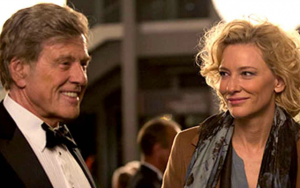 By Richard Crouse – Metro Canada
By Richard Crouse – Metro Canada
Who do you get to play an icon? If you are James Vanderbilt, director of Truth, you hire another icon.
The story of 60 Minutes producer Mary Mapes and legendary news anchor Dan Rather’s journalistic examination into President George W. Bush’s military service features Robert Redford as one of the most famous reporters of the twentieth century.
“The movie’s big buy is, ‘Are you going to see Redford all the way through or are you going to see Rather?’” says Vanderbilt. “Redford is a phenomenal actor but what he brings into a scene by just being present (is a) gravitational pull. The room turns toward him. Getting to know Dan, that’s what Dan Rather is like. When Dan Rather walks into a room, the same thing happens.
“Everybody turns into, in a good way, a teenager, because those are both voices who have been in your living room for 30 to 40 years. It’s a voice of God thing they both have and that’s why I really wanted Bob to do it.”
Vanderbilt says the legendary actor is “very easy going, the nicest guy you’ll ever meet,” but nonetheless made people on the set nervous.
“We had heads of departments who had been working in film for 30 years who couldn’t call him Bob. He would say, ‘Call me Bob,’ and they would say, ‘I’m sorry, I can’t do that Mr. Redford. I’m very sorry that is not going to happen.’”
Vanderbilt is best known as a screenwriter, penning the scripts for The Amazing Spider-Man, Zodiac, White House Down and the upcoming Independence Day 2. His screenplay for Truth is based on Mapes’ memoir Truth and Duty and reveals a time before journalism was driven by ad sales and click-throughs.
“It was pre iPhone,” he says. “It was a year before the iPhone came out and that is such a big thing in terms of how we connect to one another now. How we relate to each other. Journalists and everybody. It felt like a fulcrum point, kind of where we had been, journalistically, and where we are now.”
His research into the story gave the director a new respect for journalists.
“I think it is a very noble profession but maybe I’m a very pie in the sky guy,” he says. “I think the more young people who grow up and go, ‘This is what I want to be. I want to ask questions of power,’ the better. I think we, as a society, are better that way.”
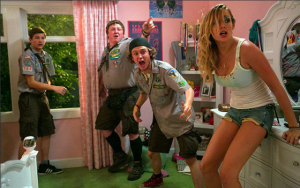 “Scouts Guide to the Zombie Apocalypse” is rated R for zombie violence and gore, sexual material, graphic nudity, and language throughout. That means no one under 17 years of age will be admitted. I think the film might better serve its audience by not admitting anyone over the age of 17 because I’m not sure anyone much past Grade 11 will enjoy the movie’s mix of burps, blood and bursting bras.
“Scouts Guide to the Zombie Apocalypse” is rated R for zombie violence and gore, sexual material, graphic nudity, and language throughout. That means no one under 17 years of age will be admitted. I think the film might better serve its audience by not admitting anyone over the age of 17 because I’m not sure anyone much past Grade 11 will enjoy the movie’s mix of burps, blood and bursting bras.
When the zombie apocalypse hit their small California town Scouts and best friends Ben (Tye Sheridan), Carter (Logan Miller) and Augie (Joey Morgan) were in the woods on a camping trip. Untouched by the biological hazard that turns almost everyone in town into bloodthirsty brain eaters, they must mobilize, and use their Scout training—knowledge of knots, decision-making and other scoutcraft skills—to locate and rescue Kendall (Halston Sage), Carter’s sister and the girl of Ben’s dreams. Aided by a gun-toting cocktail waitress (Sarah Dumont) the boys follow the letter of the Scout Law—“to help other people at all times, to keep myself physically strong, mentally awake, and morally straight.”—to battle the zombies.
OK, they’re not always morally straight, but that’s the kind of movie this is. These boys don’t miss the chance to ogle a naked zombie or sneak into a strip club.
Imagine a “The Walking Dead” with post puberty boys and pre puberty jokes (the movie’s best gag comes in the form of a zombie wearing a YOLO t-shirt.). It’s a mash-up of high-school comedies and horror that doesn’t spare the fake plasma.
It works not because it’s the best zombie comedy ever—I’d nominate “Zombieland” or “Shaun of the Dead”—or that it has the grossest kills but because it has likeable characters. The guys are typical teens placed in an extraordinary situation. They rise to the challenge of vanquishing the undead and do so while learning about acceptance and responsibility. I’m not going to say it’s a message movie—it most definitely isn’t, but under the gallons of gore is an undeniable sweetness you usually don’t find in movies that feature disembowelments and exploding heads.
I’m not sure that Lord Baden-Powell would approve of “Scouts Guide to the Zombie Apocalypse” but for the right audience it should be a good Halloween matinee.
Based on real event, “Our Brand is Crisis,” a new dramedy starring Sandra Bullock as a strategist working on a Bolivian election, shows just how fragile and easily manipulated the political process can be.
Bullock is ‘Calamity’ Jane Bodine, a reformed political animal now living a quiet life. She has traded smoking, drinking and the stresses of her old job for mountain air and a pottery kiln. When she is pulled back in the game to run the presidential campaign of unpopular Bolivian politician Pedro Gallo (Joaquim de Almeida) she finds herself face-to-face with her nemesis, Pat Candy (Billy Bob Thornton), a Machiavellian politico who wants his candidate to win at any cost. Jane knows her candidate is unlikeable and with him railing in the polls by a whopping 28 points, she crafts a wining strategy. “Don’t change the man to fit the narrative,” she says, “change the narrative to fit the man.” With Bolivia facing severe hardships she creates a campaign that plays up the country’s crisis and positions her man as a tough guy who won’t pussyfoot around the problems. “It’s better to be feared than loved,” she says.
A mix of satire, cautionary tale and earnest social commentary, “Our Brand is Crisis” succeeds primarily because of Bullock’s work in the central role. It’s her Erin Brockovich, the story of a person’s realization that her efforts can affect, both positively and negatively, the lives of a great many people. Bullock walks a fine line between Gracie Hart, her character in “Miss Congeniality” and her more serious work in films like “Extremely Loud and Incredibly Close.” The tone of her performance shifts between slapstick to heartfelt and she pulls it off, carefully calibrating the character to fit the mood of the scene.
As for Thornton, if this acting thing falls apart for Billy Bob he will be able to find work as a James Carville impersonator.
“Our Brand is Crisis” is a cynical movie that lays its cards on the table. The political electoral system, it says, is an easily manipulated game not always played in the best interests of the people. The Bolivian setting seems exotic and otherworldly at times, but the basic principles, the dirty tricks, are anything but. The film is a thought provoking piece that may make you think twice the next time you vote.